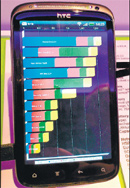 Qualcomm, a global leader in mobile chipsets, has said that its Dual Core processor for smart phones, Snapdragon MSM 8×60, will make an entry in India in a couple of months by powering the mobile device HTC Sensation which was launched in the UK in April this year.
Qualcomm, a global leader in mobile chipsets, has said that its Dual Core processor for smart phones, Snapdragon MSM 8×60, will make an entry in India in a couple of months by powering the mobile device HTC Sensation which was launched in the UK in April this year.
HTC Sensation incorporates a 4.3-inch S-LCD capacitive touch screen with a 960×540 pixel resolution. It has 768MB of RAM and a 1.5 GHz Qualcomm Snapdragon dual-core processor with an Adreno 220 GPU, making it the most powerful HTC smart phone till date. The processor supports HD video1080p capture and playback, Dolby 5.1 sound system, Stereoscopic 3D video capture & playback.
Talking to Deccan Herald, Qualcomm India Country Manager and VP Business Development Sandeep Sibal said that another high-end processor in the pipeline is a Quad Core Krait CPU that will have a speed of 2.5 GHz. Devices fitted with this processor will support full 1080p video, streoscopic 3D Video and 4 G network, Sibal pointed out.
Since Snapdragon processors lead to lower system cost, better energy management, faster time to market, they are the first choice of the smart device makers, Sibal claimed. In the year 2010, for example, 745 new devices (mobiles and tablets) entered the global market with different types of Snapdragon processors. Sibal pointed out that 60 per cent of all android handsets are powered by Qualcomm, while all Windows phones and all new HP webOS devices are powered by Qualcomm’s processors.
Sibal also said that the company is gaining quick traction in India as 13 new handsets, manufactured by different makers, have been launched with Qualcomm processors in the first five months of 2011 (Jan-May) as against only six launched in the entire 2010.
Qualcomm has two development centres in India, Bangalore and Hyderabad, and engineers here contribute significantly to the global research and development work of the company.
Incidentally, Qualcomm which has also bagged BWA (broadband wireless access) license for a few large circles in the country, has recently demonstrated its capability in LTE TDD mobility, a fourth generation mobile technology. Qualcomm jointly with Ericsson demonstrated mobility at 2.3 GHz speed in an outdoor environment at Gurgaon.
Aimed to drive the growth of mobile broadband in India, the demonstration live-streamed multiple high-definition video feeds to a mobile van, showing a seamless hand off between base stations while maintaining session continuity.